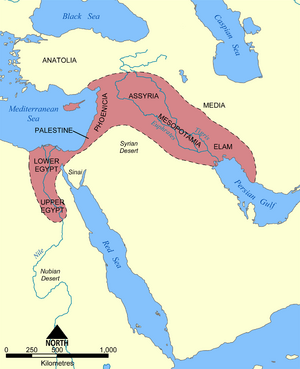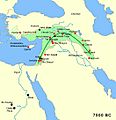Fertile Crescent facts for kids
The Fertile Crescent is a special area in the Middle East. It's shaped a bit like a crescent moon. This region is very important because it's where some of the first big civilizations began! It includes places like Mesopotamia and Ancient Egypt.
Contents
What is the Fertile Crescent?
This area got its name from an archaeologist named James Henry Breasted. He called it the "Fertile Crescent" because it was a very rich and green land in ancient times. He wanted to show how similar the cultures were in this region long ago.
Why is it Called "Fertile"?
The "fertile" part of the name comes from the important rivers that flow through this land. These rivers are the Nile, Jordan, Euphrates, and Tigris. They made the land good for farming, even though much of the surrounding area was desert. This allowed people to grow food and build large communities.
Where is the Fertile Crescent Today?
The Fertile Crescent stretches from the eastern coast of the Mediterranean Sea. It goes around the north of the Syrian Desert and through the lands between the Tigris and Euphrates rivers, all the way to the Persian Gulf.
Today, parts of the Fertile Crescent are found in these countries:
- Egypt
- Israel
- West Bank
- Gaza Strip
- Lebanon
- Parts of Jordan
- Parts of Syria
- Parts of Iraq
- South-eastern Turkey
- South-western Iran
Why is the Fertile Crescent Important?
The Fertile Crescent has a very long history of human activity. It is often called the "Cradle of Civilization." This is because many important inventions and ideas started here. These include farming, writing, and the first cities.
Related pages
Images for kids
-
A 15th century copy of Ptolemy's fourth Asian map, depicting the area known as the Fertile Crescent
-
1916 map of the Fertile Crescent by James H. Breasted, who popularised usage of the phrase.
-
Area of the fertile crescent, circa 7500 BCE, with main sites of the Pre-Pottery Neolithic period. The area of Mesopotamia proper was not yet settled by humans. Includes Göbekli Tepe, a site in modern-day Turkey that is dated circa 9000 BCE.
See also
 In Spanish: Creciente Fértil para niños
In Spanish: Creciente Fértil para niños






